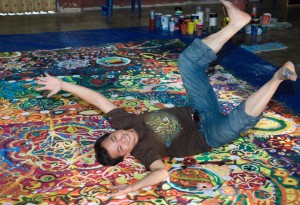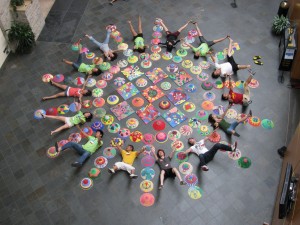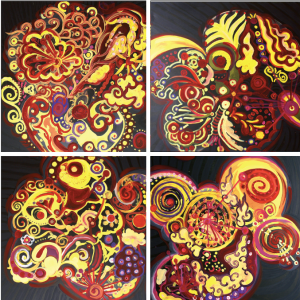This is the first blog by our newest diaCRITIC, Jade Hidle:
To understand the ache for, and seeming impossibility of, a perfect circle, you don’t need to be a renowned artist with your name and birth year on a plaque in some fancy art museum. In fact, if you’re like me, your artistic skills haven’t progressed since you were five, when your renderings of the human body forgot necks and amplified hands to grotesque proportions. But it is during this grade school period of our lives that the perfect circle is first introduced to us—the delicate bounce and sway of spray-painted spheres in a Styrofoam solar system, the letter “o” mockingly rotund and symmetrical in its place on the laminated alphabet chart on the classroom wall, the tetherball whipping around its pole over your head, out of reach. In Platonic fashion, these perfect circles seem far removed from us because we feel, and are told, that we cannot create them. Still, we try. With our pudgy fingers gripping the pencil, our heads tilted, our tongues pressed firmly in the corner of our mouths in concentration, we draft, one after another, circles that look more like thumbprint-dented avocadoes, deflating kickballs.
Hiep Cao Nguyen, founder and director of the Circle Painting Project (www.circlepainting.org), is showing us that it is possible to create circles more perfect. Circle Painting has been a non-profit organization for four years, over the course of which Hiep has drawn people together in locales across the globe—a children’s cancer hospital in Việt Nam, the Millenia Mall in Singapore, a Boys and Girls center in Long Beach, California, to name a few—all for the purpose of creating (comm)unity by painting murals consisting of vibrantly colorful and contiguous circles. To view one of these murals is to see the “perfect” circle that tortured us during grade school liberated from its finite state to be birthed into a frenzy of color and sense of possibility within and between circles. These murals are a visual manifestation of boundaries come undone—both in regard to the circles painted in harmonious overlap, as well as to the diverse groups of people united in their creation.
The genesis of Circle Painting dates back ten years when Hiep returned to Việt Nam for the first time since immigrating to the United States, and completed his very first painting of a mandala-influenced circle in Ðà Lạt. He describes this experience as healing for his Vietnamese-American identity: “Probably like most Vietnamese-Americans who live here long enough to feel strange in their homeland, I always feel strange in America [too]. I feel like now I’ve found something that is universal that releases me from being stuck in Việt Nam as a Vietnamese and [from] the struggle to identify as an American. In the process of doing Circle Painting I see that I have overcome that. Now I can be anywhere. I don’t have to have that struggle of identity weighing me down.”

To that end, Circle Painting has afforded numerous individuals the opportunity to express and heals wounds unseen. Most recently, Hiep and Circle Painting joined forces with the Catalyst Foundation (www.catalystfoundation.org) this summer to bring together hundreds of children who were adopted from Việt Nam and are now living with their adoptive families in predominantly Caucasian areas in Minnesota and Connecticut. For these children who generally do not have regular exposure to Vietnamese language or culture, Hiep chose to have the adoptees paint traditional non la (straw hats). As most people are familiar with the “quaint” postcard image of conical hats dotting the rice paddies of Việt Nam’s countryside, the selection of this object in lieu of a common canvas gave the children an opportunity to transform an iconic, if not stereotypical, representation of Vietnamese culture into a unique, individual, and personal work of art. In essence, these children of Việt Nam were able to make the seemingly distant Vietnamese culture their own, at least for a day.

And, according to Hiep, the adoptees’ identities underwent a more subtle and, perhaps, more important affirmation during these culture camps: “[It was rewarding] just to be there with them, for them to see a Vietnamese guy who do[es] this crazy thing and he’s in power. I imagine if I were a little kid and someone looked like me and he has some respect from other people and helps me to do this cool thing, I imagine there’s some moment of [being] proud.” As I listen to Hiep describe these children’s moment of self-recognition and belonging, I recall my elementary school days of wondering how to color myself Vietnamese-Norwegian while I stared, perplexed, at my 24-pack of Crayolas. Yellow? Peach? Ticonderoga? (This was long before the company unveiled the skin color edition crayons, which really only makes me want to give them a pat on the head and click my tongue in the way that only a Vietnamese mother can.) For all of us who have felt different from others or estranged from our reflections in the mirror, we can appreciate the gravity of the message that it is okay to look and be just the way you are.

Beyond meeting such needs of Vietnamese living in the United States, Circle Painting has confronted, and continues to overcome, the challenges of instituting and maintaining a community-based art project in the homeland of Việt Nam. In Hanoi, Hiep experienced initial resistance to the project; people told him that he could not institute (and might even encounter hostile reactions to) such a program focused on artistic expression and communal involvement. However, it was exactly these two facets of the program that made the painting in Hanoi one of the most rewarding experiences for the Project. Hiep reflects that, in particular, the youth in Việt Nam became very supportive, eager to be involved in art not dictated by the government. “It’s political and not political in that sense,” Hiep says. In this way, it seems, Hiep’s work in Việt Nam indicates that the country and its people are presently, actively, undergoing important changes to reconcile their identities with a national history perceived as dominated by war and communism, that the sense of community and what it means to be Vietnamese is constantly evolving and we are continuing to learn how to express this.
Likewise, Hiep has been solicited to serve and represent the Vietnamese-American communities in the Gulf who are struggling through the repercussions of the oil spills. In occupying this position of offering people an opportunity to heal, Hiep’s Circle Painting Project connects Vietnamese people all over the globe.
Hiep, though, wants to clarify the misconceptions that Circle Painting is only for Vietnamese people or only for children. He feels that a community-based art project like Circle Painting is well-suited for anyone who feels isolated—children, businesspeople harnessed by the walls of their cubicles, anyone and everyone.
Under the influence of Circle Painting, Hiep is enjoying how his own artwork has begun to extend beyond the boundaries of his individual self. “Now when I paint alone,” Hiep says, “I feel like [I am] missing something. When I work with another person, the constant changing of interact[ion] is more stimulating.” This craving has translated into inventive uses of the online community of Facebook. Currently, Hiep’s Facebook friends can comment on albums of his sketches, and their responses will be compiled in a book. By validating viewers’ active participation in the process of artistic interpretation, Hiep is taking art off of the austere exhibit wall, so to speak, and making it more accessible to a wider audience, reinforcing Circle Painting’s philosophy that art is a communal, ever-evolving entity—one that is both personal yet also reminiscent of the comforting idea that we are all inextricably tied to one another.
While Hiep has accomplished much already, he is currently working on the 50/50 Project, an effort to achieve nationwide collaboration by painting circle murals in all fifty states. Beyond 50/50, Hiep is also working on expanding the Circle Painting Project into a series of festivals that include music, dance, and other forms of artistic expression. In line with his philosophies of community-based art, Hiep recognizes that the nature of Circle Painting events will evolve as the Project continues to develop and include more people. “Eventually,” Hiep says, “it’s not about Circle Painting. It’s about something bigger.”
To learn more about, volunteer for, or donate to Circle Painting, visit www.circlepainting.org.
–Jade Hidle
~
Did you like this post? Then please take the time to rate it (above) and share it (below). Ratings for top posts are listed on the sidebar. Sharing (on email, Facebook, etc.) helps spread the word about diaCRITICS. Thanks!





Congrats Hiep on both: finding your identity in your art work and your Circle Painting Organization. Thanks for connecting my life to the Circle painting. Hopefully I’ll have the opportunity to participate in one of your Circle painting project real soon. All the best wishes to the Circle Painting Organization.
Such wonderful, beautiful and giving work!
Painting circles has brightened my Saturday mornings. Hiep is so calm and friendly, his positive and welcoming personality alongside tai chi and chanting, sprout in me the freedom to create and circle paint better than I ever thought I could. I hope to be able to volunteer as much as possible for a long time!
Thank you Mike. Hope our path will cross and we’ll connect, create, and celebrate together again.
I’d love to have you to join us for our upcoming projects in Hong Kong, Macau, Vietnam, Singapore, and of course, USA.
Hiep is so sensitive to his participants. I know because I have had the opportunity to be one. I love the process as well as the product. Teresa
I love the exploding color that results from an entire community’s input into a piece of art.
I remember reading an article years ago that talked about an older woman who had moved into a new neighborhood and was disappointed at the unsocial attitudes of her neighbors. She decided to open her garage up, lay out an array of paints, and put up a huge, blank canvas. She then began inviting everyone she saw to paint. At first, only the kids took her up on her offer, but the adults soon followed, and, within months, the entire neighborhood was having monthly block parties.
Communal activities for the sake of communing are quickly becoming an endangered species in the U.S. of A. and it’s depressing to think about the range of relationships that most people are missing out on.
And I really want to hear a Vietnamese mother “clicking.”
Dear Diacritics,
This is absolutely fantastic. I love the art, and the methods and philosophies through which it is created.
The perfect circle is truly a sort of holy grail, and I can’t think of anything more noble than to teach humans how to create grails where none perhaps existed before.
Yours Truly,
-Both
Thank you for your comment. Much appreciate it.